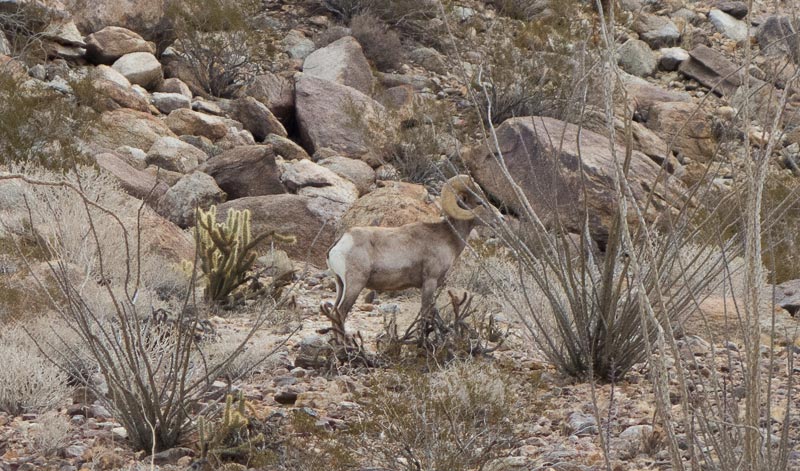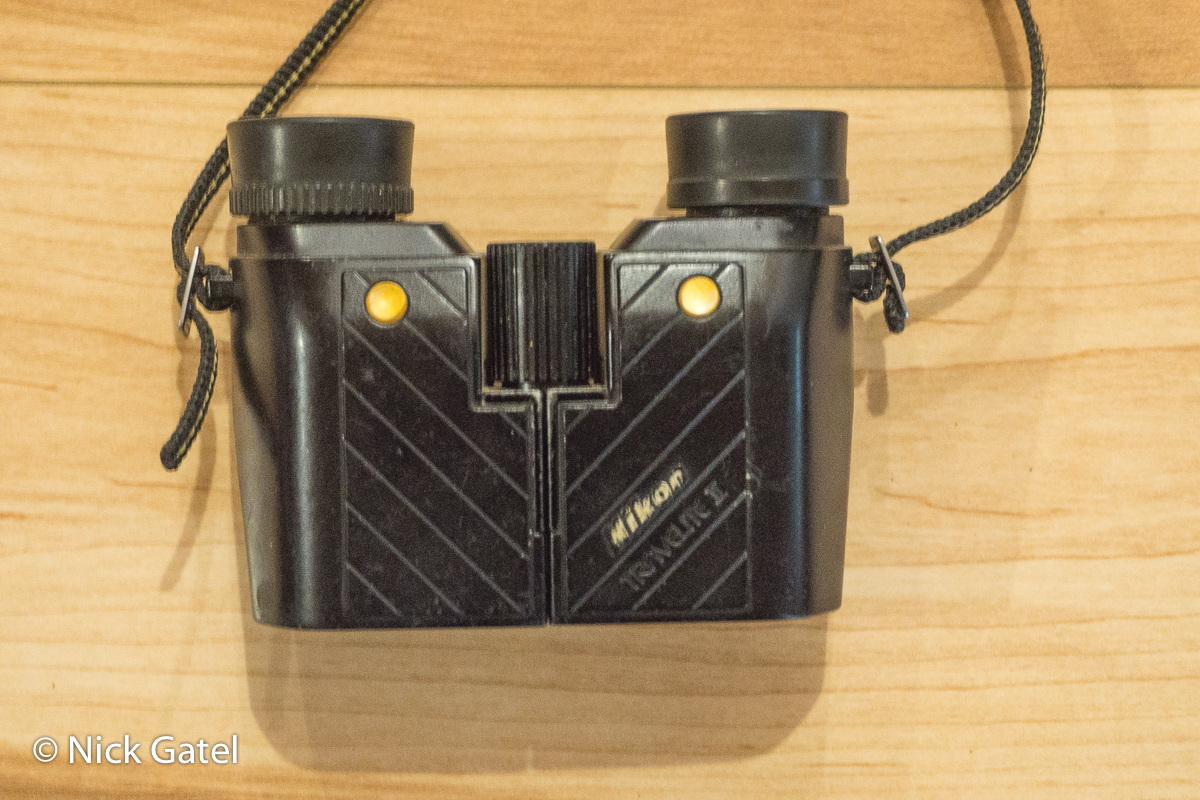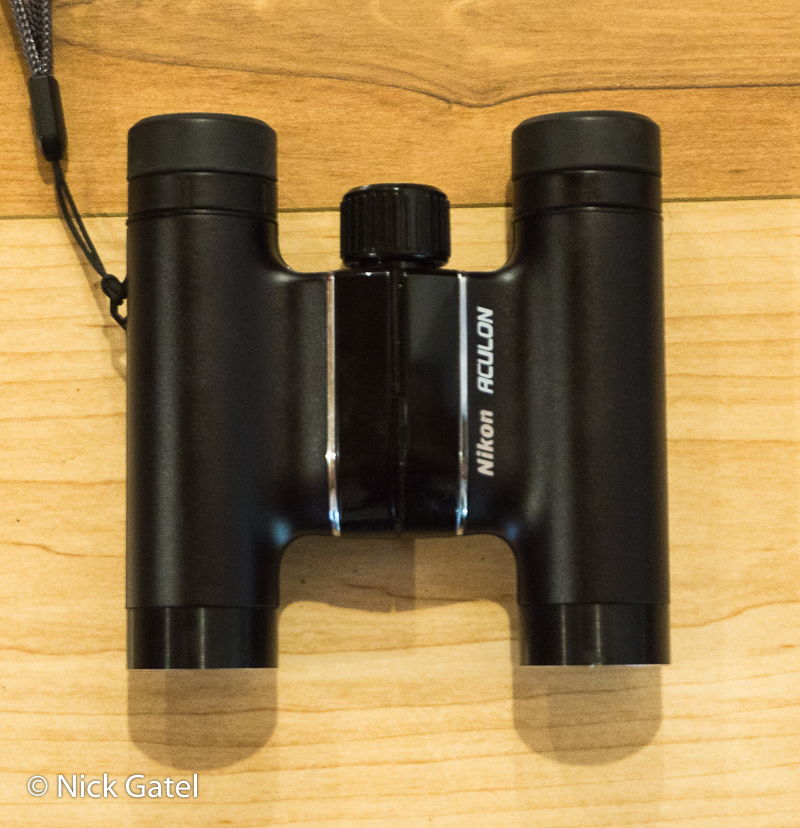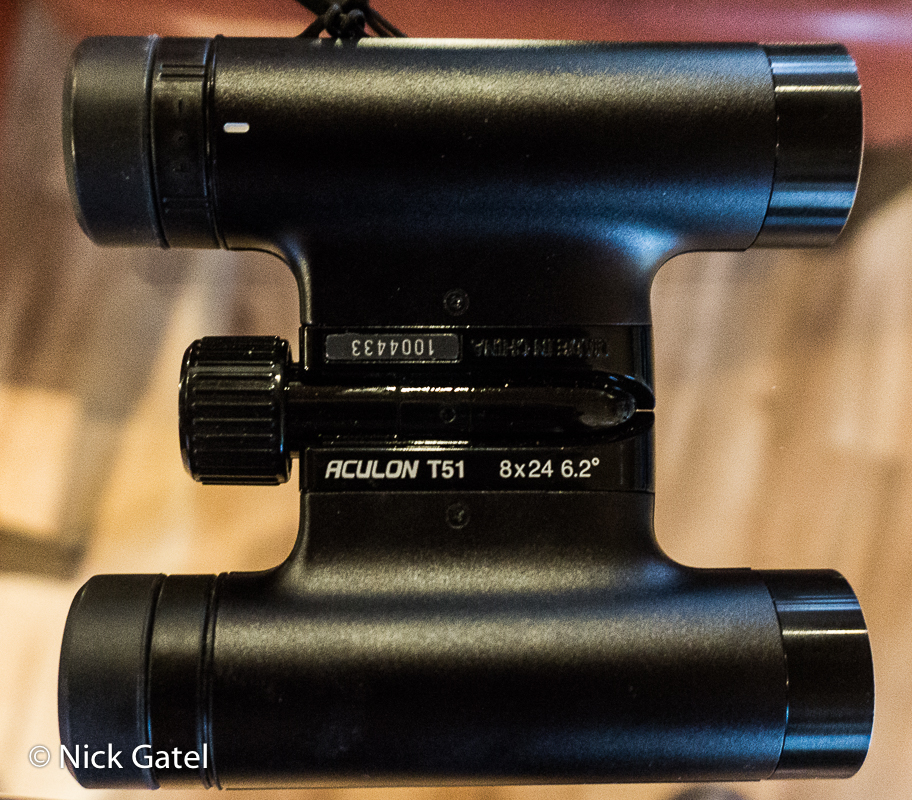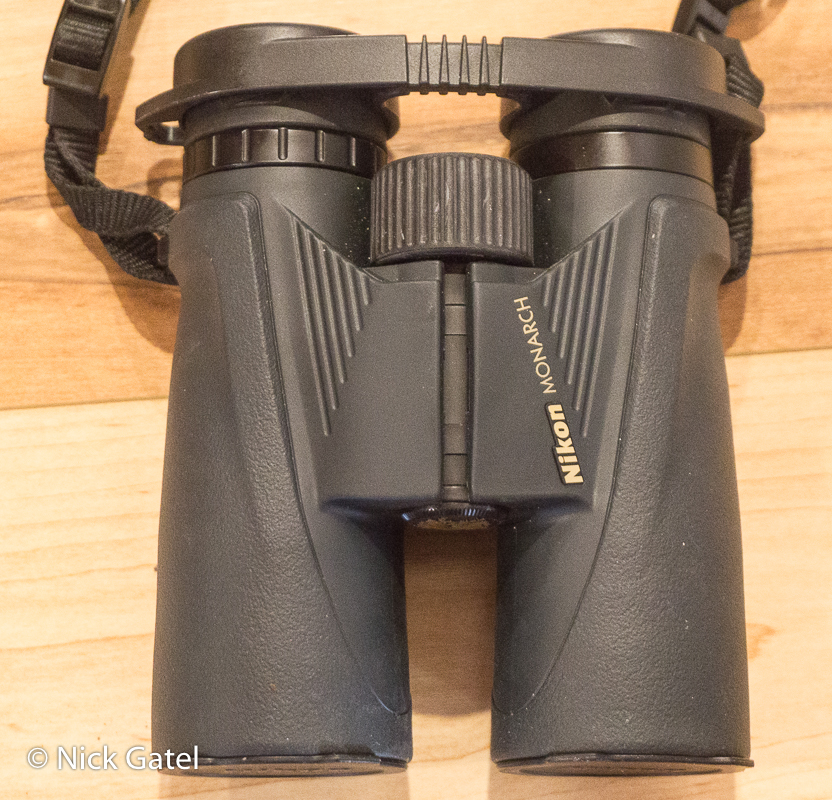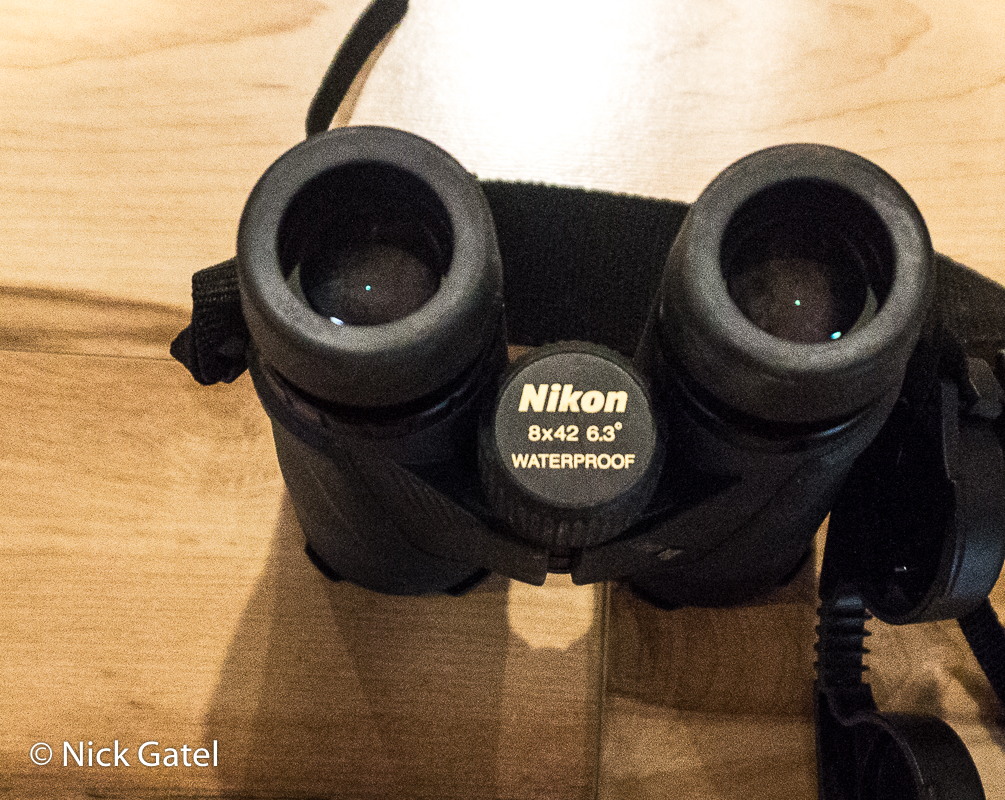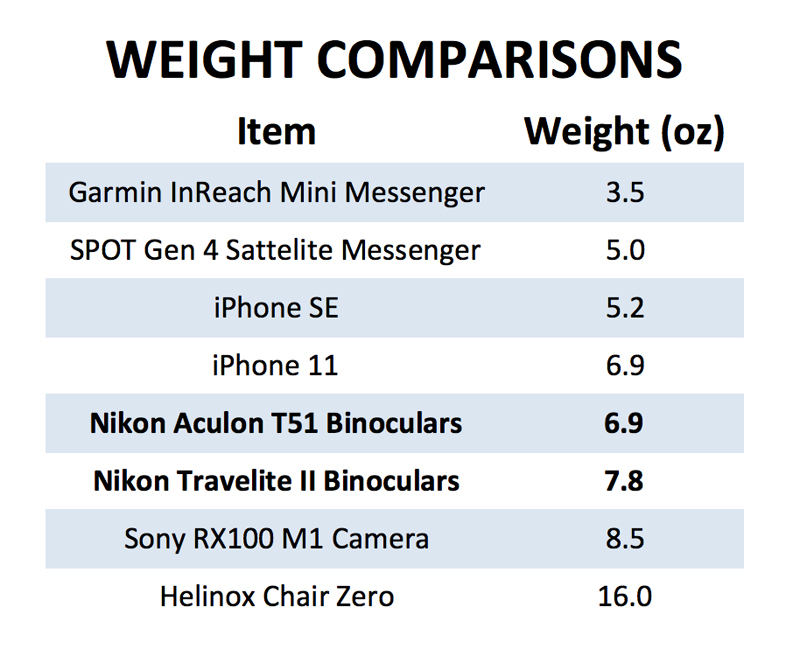This isn’t a tutorial on binoculars, nor is it a product review. I simply would like you to consider the benefits of making a lightweight, compact binocular a part of your everyday backpacking gear.
I’ve never met a backpacker who regularly carries binoculars. To me this seems odd, because a compact binocular can be such a useful tool. Back around 2008, I stopped taking binoculars on most trips for about five years, because I was too focused on the weight of my gear. On most trips, binoculars were not a critical “keep me alive” piece of equipment. After realizing my mistake, I, again, now carry compact binoculars on almost every trip.
But I am still in the infinitesimal minority. If you never, or infrequently take binoculars backpacking, perhaps this might be a good time to re-consider.
I do know a few backpackers who carry binoculars when hunting, that is, when a backpacking trip is also a hunting trip.
From what they tell me (or write on their blogs), these hunters spend considerable time sitting and scanning an area in search of game. Apparently, for many hunters, binoculars are a piece of mandatory equipment, just as a sleeping bag, stove, and shelter is for most backpackers.
It would seem, and is true for most backpackers, observing wildlife is one of prime goals for walking. If the hunter needs binoculars, then maybe, just maybe, the non-hunting backpacker might want to consider bringing (and using binoculars).
For example, a few years ago I was in an area that looked to be prime Bighorn habitat. Scanning the terrain, I couldn’t see any. I sat down on a boulder, took out my binoculars and slowly started examining the area. In a few minutes, I spotted a large ram that blended into the boulders and vegetation. At the same time, I could see a game trail he was slowly following.
Not only could I see him, but also I could easily pick out the entire length of the trail he was traversing. Bighorns are skittish creatures and are easily spooked. Slowly and quietly, I moved to a section of the game trail I hoped he would eventually get to and sat down. About 10 minutes later, he was close enough for a great picture.
Notice how the sheep’s coloring and shape blends in with the rock formations and plants. The picture is nice, but what was much more captivating was watching his movements and muscles, hoof placement, his eyes and nostrils, all while he moved carefully down the game trail — the totality of a magnificent animal in the wild — all of this with a small and lightweight binoculars.
Birds are another obvious target for viewing, even if one isn’t a birdwatcher; you know, that species of humans who spend much time watching birds and building a life list of sightings. I’m not one. On the other hand, I remember spending a late afternoon and early evening absorbed with the comings and goings of hundreds of cliff swallows above a meandering river.
Condors, Golden and Bald eagles, vultures, and other hawks make for wonderful diversions.
One just needs to take a bit of time, stop, and watch. There is a lot going on in the wilderness we often do not notice. Frequent binocular viewing sessions will help the backpacker learn to become more focused on the world around them, instead of just the huge panoramic world unfolding in the distance.
Other Uses
Microscope
Not really a microscope, but a tool to watch the miniature world of insects close up. I have spent countless hours observing battalions of ants marching to and fro.
Investigating bees and butterflies can suck up an entire afternoon’s worth of time. What one can observe is only limited by their imagination.
Navigation
I do a lot of off-trail, cross-country hiking. Here binoculars can really shine as a most useful tool.
Topo maps are not detailed enough to determine the steepness of a granite pour-over or a talus covered pass. Often scouting possible routes beforehand with binoculars can save hours of futile attempts to navigate these routes and even prevent the need to turn back from an impassible natural barrier.
Firestarter
I’ve never tried it, but one could turn the binoculars upside down (large lens facing the sun) and start a fire, just as one can do with a magnifying glass.
Just to state the facts: I’m no expert on binoculars, although I’ve been using them for decades.
Numbers
Most binoculars come with three numbers stamped on them:
- Magnification
- Objective Lens Diameter
- Field of Vision
Magnification
A simple way of describing this is:
- A magnification of 7 means an object 700 yards away appears as it would at 100 yards to the naked eye.
- A magnification of 8 means an object 800 yards away appears as it would at 100 yards to the naked eye.
A magnification of 10 or higher often results in the user having difficulty keeping the binocular steady without the aid of a tripod or other external object to keep the binoculars from shaking, especially when observing for a length of time.
Object Lens Diameter
This is the diameter (in millimeters) of the big lenses, that is, the lens at the end of the binoculars closest to the object your are viewing; or the end you do not hold up to your eyes. The wider the lens the more light that is captured and the easier it is to see in dimmer light.
When the diameter is much more than 5 times the magnification, the harder it is to hold the binocular steady. If one is doing a lot of night viewing, such as stars and planets, then a wide diameter lens with a tripod is your best bet.
Field of View
This is how wide an area is captured through the lens. Often, the higher the magnification, the narrower the field of view. For most people, this number isn’t as important as the first two.
Other Considerations
Eyecups
These are rubber cups that extent above the viewing lens. They help to keep the eyes the proper distance from the eyepiece and, at the same time, limit the amount of ambient light hitting the eyes above the eyepiece.
Some cups are flush with the eyepiece and can be twisted up. Others are fixed above the eyepiece and can be folded or pushed down for those who wear glasses. Those who wear glasses don’t want to use the eyecups because it forces their eyes too far from the eyepiece.
Some binoculars do not have eyecups.
Waterproof
You do not want water or moisture to get inside the lens assembly. Even a minute amount of moisture can cause condensation. Waterproof binoculars cost more and add weight.
Armor
Binoculars are precision pieces optical equipment, subject to the bangs and bruises of handling and storage. Armored coverings help protect them, and like waterproofing, add weight bulk, and cost.
Selecting Binoculars
Quality
Binocular choice is a personal matter. What works for me, may not work for you. In addition to magnification, objective lens diameter, field of vision, waterproofness and toughness, lens quality and coatings a significant considerations. High quality name brand binoculars can cost hundreds, if not thousands, of dollars. Cheap $50 units may perform poorly and not last long. Most people will want something in the middle — good performance with durability. But even this cannot be “measured.”
You Have to “Try Them Out”
The best was is to look through a bunch of binoculars and determine what works best for you. This means going to a brick and mortar store, unless you want to buy a dozen different ones online, pick one, and send eleven back, all of which is a huge hassle.
Large stores like REI, Bass Pro Shops, etc. usually have a good selection in stock and will let you try out different models.
What I Use
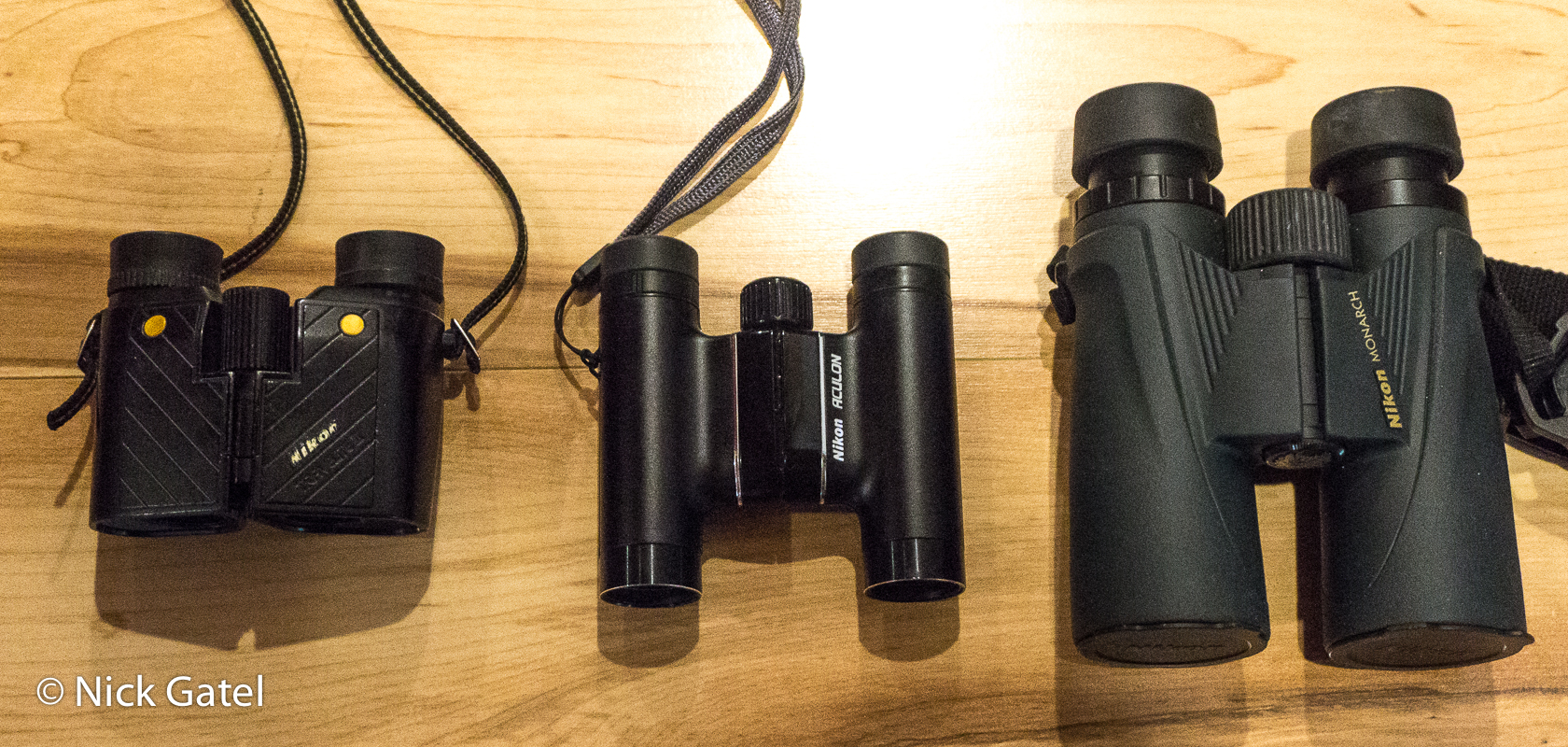
I have used bought Nikon binoculars. Quality optics and durable — depending on what models you purchase. Lower priced models simply aren’t as good as the more expensive. And with anything, each model has its feature and benefits, and at the same time, not so good aspects. However, Nikon are probably not at the top of the food chain when it comes to high quality optics and, of course, a corresponding stratosphere price tag.
So let’s look at the three Nikon binoculars I have used, and still use, for the past 30 years or so.
Also keep in mind; these are not just for backpacking. One pair I keep in our camper most of the time, another pair in my truck, and one pair has been my go-to binoculars for the past 6 or 7 years.
The first two, the Travelite II and the Aculon T51 are no longer made. Newer versions of Travelite and Aculon are sold, but you shouldn’t assume they are the same quality. You need try them in person.
Nikon Travelite II (7 x 20)
These are fairly compact, but rather wide for the size. They’re quite light at 7.8 ounces.
I’ve had these probably close to 30 years and they’ve held up well.
The eyecups are not adjustable.
Over the years the folding hinge has become loose and is not something that is user adjustable, but they still function well.
The 20mm objective lens doesn’t capture a lot of light, which is why I replaced them for backpacking with the Aculon T51 6 or 7 years ago.
In spite of all these seemingly imperfections, the Travelite II has been a solid performer.
Nikon Aculon T51 (8 x 24)
These are much brighter than my Travelite II. The optics are probably better along with a objective lenses that are only 4mm wider. They are not as bulky and easily slip into my pants pocket, where I normally carry them. Other times I carry them in one of my backpack hip belt pockets.
Weight is a minimal 6.9 ounces.
One draw back is they do not have eyecups, which hasn’t been a problem for me, although eyecups would make them easier to use for long periods. I could probably find some aftermarket eyecups to add to them, but it hasn’t been that much of an issue.
The Aculon comes with a wrist strap that connects to a single point on the binocular body. I could buy a single point neck strap, but over the years I have gotten away from neck straps. I find them inconvenient and the binoculars are always getting in the way when I’m not using them.
Nikon Monarch 5 (8 x 42)
I’ve had these for at least 15 years. They are too big and heavy for general backpacking use (24 ounces with the neck strap). The Monarchs are a favorite among hunters and birdwatchers.
They have nice adjustable eyecups, are, completely waterproof, and have a rugged rubber covering. I keep them in the camper and we use them on most camping trips (Joyce likes them too).
Closing Thoughts
Weight
Any item in your pack should be scrutinized for function, weight, and durability. The benefits have already been laid out. Quality, compact binoculars have become quite lightweight.
Below is a chart of common backpacking items compared with the Nikon Travelite II and the Aculon T51.
Time
Binoculars can become quite addicting. Instead of getting from point A to B in a certain amount of time, on can become distracted with the world around you instead, as there is so much to be seen close up. Is this a bad thing?
Given this, on the rare occasions I hike with a group, I leave the binoculars at home, as I would never keep up with the group, and would be constantly roaming off the planned route looking at the really important things.
Useful Links
How to Choose Binoculars (REI)
In case anyone cares, I bought all these items, as I always do, with my own money, paying the regular prices as all customers.
This website may be compensated for linking to other sites or for sales of products. As an Amazon Associate I earn a small fee from qualifying purchases at no additional cost to the purchaser.

